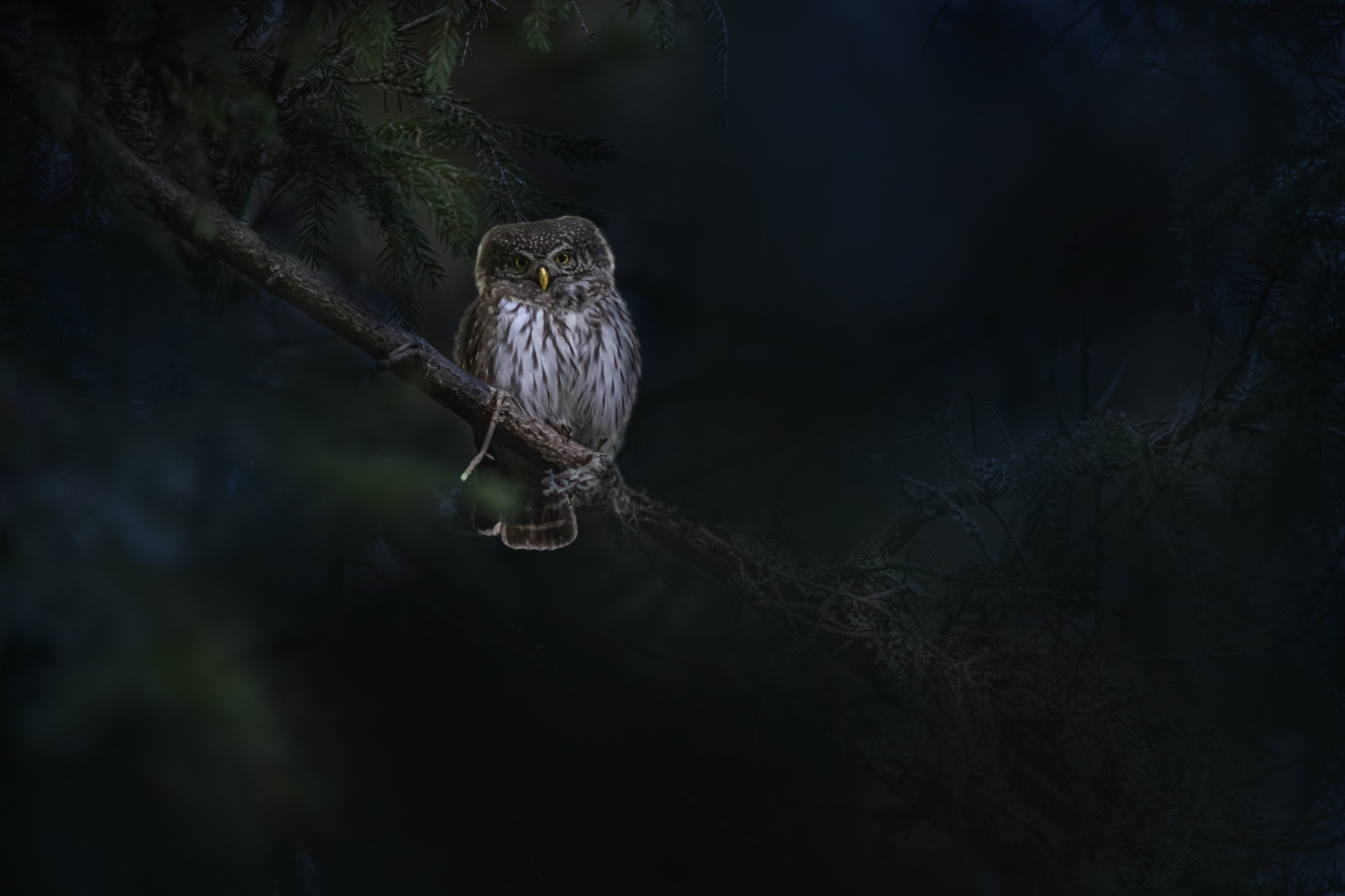Here’s a comprehensive overview of the Eurasian Pygmy Owl (Glaucidium passerinum) — Europe’s smallest and one of its most fascinating owls.
🦉 Eurasian Pygmy Owl (Glaucidium passerinum)
Taxonomy
- Kingdom: Animalia
- Phylum: Chordata
- Class: Aves
- Order: Strigiformes
- Family: Strigidae
- Genus: Glaucidium
- Species: Glaucidium passerinum
Common names: Eurasian Pygmy Owl, Pygmy Owl
Scientific name: Glaucidium passerinum
The smallest owl species in Europe.
General Description
The Eurasian Pygmy Owl is a tiny, compact owl with a rounded head, yellow eyes, and no ear tufts. Despite its small size, it’s a bold and efficient predator, capable of catching birds nearly as large as itself.
- Length: 15–19 cm
- Wingspan: 32–39 cm
- Weight: 50–70 g
- Plumage:
- Upperparts: Brown with fine white spots
- Underparts: White with brown streaks
- Tail: Dark brown with light bands
- Eyes: Bright yellow
- Beak: Yellowish, short and hooked
Males and females look alike, though females are slightly larger.
Distribution and Range
The Eurasian pygmy owl is found across the boreal and montane forests of northern and central Eurasia.
Range includes:
- Northern and central Europe: Scandinavia, Finland, Baltic states, Poland, Germany, Austria, Switzerland
- Eastern Europe to Asia: Russia, the Caucasus, Siberia
- Southern Europe: Mountainous regions of the Alps, Carpathians, Balkans
Habitat altitude: Sea level in northern ranges to 2000 m in the mountains of central Europe.
Habitat
Prefers coniferous and mixed forests, especially:
- Spruce, pine, and fir forests
- Areas with old trees and natural cavities
- Forest edges and clearings with high prey density
Nests almost exclusively in old woodpecker holes (especially those made by the great spotted woodpecker).
Behavior and Ecology
The Eurasian pygmy owl is diurnal and crepuscular, meaning it hunts during the early morning and late afternoon, unlike most nocturnal owls.
- Activity: Active during twilight; perches silently when hunting.
- Territorial: Males defend territories vigorously with clear, high-pitched whistling calls.
- Perch hunting: Often hunts from a low perch, swooping swiftly onto prey.
- Caching behavior: Stores surplus prey in tree holes or branches for later consumption, particularly in winter.
Diet
A carnivorous predator, feeding primarily on:
- Small birds: Tits, finches, sparrows, redpolls
- Small mammals: Voles, shrews, mice
- Occasionally: Large insects, lizards
Diet varies seasonally — more birds in summer, more rodents in winter.
Reproduction
- Breeding season: April to June
- Nesting site: Old woodpecker holes, often in spruce trees
- Clutch size: 3–7 white eggs
- Incubation: 28–29 days (female only)
- Fledging: Young leave the nest after 30–35 days
- Parental roles:
- Male provides food for the female and chicks
- Female guards and broods young
Young become independent in late summer but may remain near the natal area for several weeks.
Vocalizations
- Male’s song: A series of soft, clear “poo-poo-poo-poo” notes spaced evenly every 1–2 seconds.
- Female call: Higher-pitched or softer version.
- Used for territory defense and mating communication.
- Calls are often heard at dawn or dusk in spring.
Predators
- Larger owls (Tengmalm’s owl, Ural owl)
- Martens and other forest predators
- Occasionally birds of prey like goshawks
Despite its size, the pygmy owl’s cryptic plumage and alertness help it avoid most predators.
Lifespan
- Average: 3–6 years in the wild
- Maximum recorded: About 7–8 years
Mortality is highest during the first year, mainly due to predation and harsh winters.
Conservation Status
- IUCN Red List: 🟩 Least Concern
- Population trend: Stable, though locally affected by forest management
Main threats:
- Loss of old-growth forest with nesting holes
- Removal of dead trees and snags
- Habitat fragmentation
Conservation measures:
- Preserving mature coniferous forests
- Installing artificial nest boxes
- Protecting old woodpecker populations (as they create potential nest sites)
Identification Summary
| Feature | Description |
|---|---|
| Scientific Name | Glaucidium passerinum |
| Common Name | Eurasian Pygmy Owl |
| Length | 15–19 cm |
| Wingspan | 32–39 cm |
| Weight | 50–70 g |
| Coloration | Brown upperparts, white underparts with streaks |
| Eyes | Bright yellow |
| Tail | Short, barred |
| Activity | Diurnal hunter |
| Diet | Small birds and mammals |
| Habitat | Boreal and montane forests |
| Conservation | Least Concern |
Interesting Facts
- The smallest owl in Europe, but surprisingly fierce — capable of killing prey nearly its own size.
- Caches prey in tree holes, sometimes storing more than a dozen small animals.
- One of the few owls active in daylight — often spotted perched on a low branch.
- Their presence often attracts alarm calls from small birds, revealing the owl’s location.
- They can turn their head 270°, like other owls, to scan for prey and threats.
Ecological Role
- Helps control populations of small mammals and songbirds.
- Acts as an indicator of healthy, mature forest ecosystems.
Summary
The Eurasian Pygmy Owl (Glaucidium passerinum) is a tiny, charismatic predator inhabiting Europe’s and Asia’s coniferous forests. Despite its size, it is a fearless hunter, hunting by day and caching food for winter. Its bright yellow eyes, soft calls, and bold behavior make it a favorite among birdwatchers and forest naturalists.
Views: 1410
Subscribe to the newsletter:
